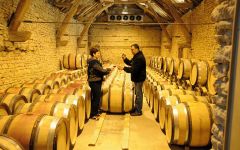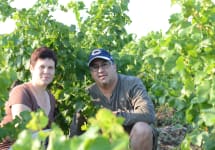Rotem & Mounir Saouma Chateauneuf-du-Pape Arioso 2013
-
Jeb
Dunnuck -
Wine
Spectator



Product Details
Your Rating
Somm Note
Winemaker Notes
From his original 5 acres in Pignan, Mounir has one plot, of 100% Grenache planted in the 1930s, which yields naturally at a miniscule 1 ton per acre. From these vines he produces Arioso, a Chateauneuf of astounding depth and finesse.
Professional Ratings
-
Jeb Dunnuck
Tasting like a Grand Cru from Chambertin, the 2013 Châteauneuf-Du-Pape Arioso is 100% Grenache from the Pignan plateau that spent three years in barrel, on lees, before being bottled unfined and unfiltered. Black cherry, forest floor, spring flowers, damp earth, and spice all flow to a medium-bodied, ethereally textured, seamless 2013 that opens up beautifully with time in the glass. Again, this is unquestionably a Burgundy lover’s Châteauneuf, and it shines more for its nuance, elegance, and complex more so than outright power and richness. With bright, yet integrated acidity and ample, sweet tannin, it’s a sensational 2013 and one of the best from the vintage.
-
Wine Spectator
Beguiling, with Lapsang souchong tea, singed cinnamon, clove and warm cassis aromas leading the way for a rich and silky core of crushed cherry and raspberry fruit flavors. Everything glides together through the refined, incense-filled finish. Best from 2020 through 2035. 12 cases imported.
Other Vintages
2019-
Wine
Spectator
- Vinous
-
Wine
Spectator -
Wine &
Spirits
-
Jeb
Dunnuck -
Wine
Spectator
-
Wine
Spectator -
Jeb
Dunnuck - Decanter
-
Jeb
Dunnuck




Let’s start at the beginning: five acres in Pignan. A sale was being conducted through the French state that presented the opportunity to buy a somewhat neglected parcel adjoining some outstanding plots (notably Rayas’ Bois de Rayas and the Pignan lieu-dit). The Saoumas have long loved the area and its wines, have many friends and saw they could potentially acquire land in a way that would not be possible in Burgundy. The sheer vitality of these vines today is extraordinary.
They know and love Mounir Saouma because of the way he transmits both unknown and acknowledged great crus of Burgundy through his elevage into masterpieces, but it turns out he may be an even more talented vineyard manager. Mounir’s philosophy is in theory straightforward. He has worked to improve drainage in his vineyards, works with organic manures, and doesn’t mind the low yields he is getting in his plots. As is the case with most things in life, simplicity appears only after deliberation and experience. From this plot, Mounir has been able to acquire additional vineyards, and today farms a total of 21 acres across eight vineyards in all five villages of the appellation (Chateauneuf-du-Pape, Bedarrides, Sorgues, Courthezon, and Orange).
The kaleidoscope of the terroirs he works with is reflected in the cellar, as well, where a combination of barrels, foudres, cement, and eggs are used, all except the last of which can be considered “traditional” within the diversity of Chateauneuf’s viticultural history. The fruit is pressed firmly with small presses dating from the late 1970s, left in tank to macerate at relatively cool temperatures for 8 days, and then transferred to the various vessels. The wines are never punched down, never racked, and never sulfured until a light addition a month before bottling. They age for between 24-36 months, including the white, which as you might expect has an outsized focus here.
The wines are stunning: precise, intense, complex, expressive visions of Chateauneuf.
